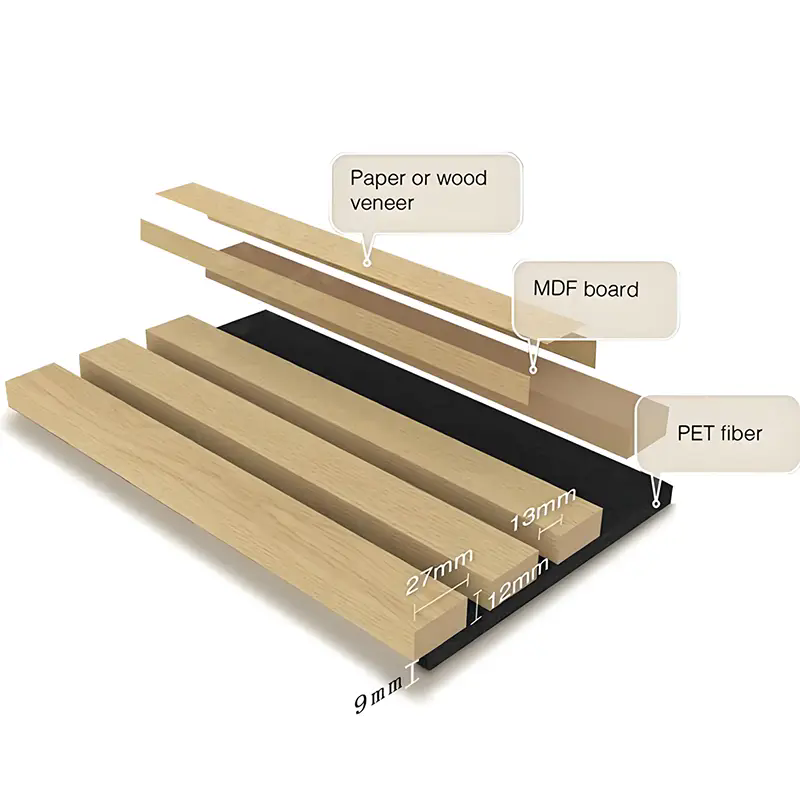What Role Will Acoustic Panels Play in Sound-Controlled Interiors?
2025-10-23
A new generation of acoustic panels is transforming how spaces such as offices, restaurants, studios and homes handle sound. These panels, commonly described under the term “acoustic panel”, are specially engineered sound-absorbing fixtures designed to reduce echo, reverberation, and improve speech intelligibility and general auditory comfort. They are not only functional but increasingly aesthetic.
Product Parameters
Here is a summary of typical technical specifications for a mid-to-high performance acoustic panel, as a reference:
| Parameter | Typical Value / Description |
|---|---|
| Core Material | Fiberglass, mineral wool, open-cell foam |
| Surface Finish | Fabric wrap, PET felt, wood-wool board, wood veneer |
| Absorption Performance | Noise Reduction Coefficient (NRC) ~ 0.70-0.95 |
| Panel Size | e.g., 600 mm × 1200 mm or 2400 mm × 1200 mm (customisable) |
| Thickness | 30 mm to 100 mm (depending on frequency band targeted) |
| Mounting Style | Wall-mounted, ceiling-suspended, freestanding screen |
| Fire Rating | Class A or B (depending on region) |
| Aesthetic Options | Colour, shape, pattern, branding integration |
These parameters reflect typical mid-to-high end acoustic panels available today and can be customised further for bespoke installations.
What Are Acoustic Panels?
What
An acoustic panel is essentially a sound-absorbing panel designed to improve the acoustic environment by reducing reflected sound waves (echo and reverberation) inside a room.Typically they consist of a porous core material (such as fiberglass, mineral wool or foam) wrapped or finished with an acoustically transparent surface material (fabric, felt, wood-wool, etc.).
Why
-
To improve speech clarity and intelligibility in spaces such as meeting rooms, educational facilities and studios.
-
To reduce background noise and reverberation in open-plan offices, restaurants and hospitality environments, thus enhancing comfort and productivity.
-
To integrate seamlessly into interior design: acoustic panels nowadays are expected not only to perform but also to look good, matching decor or branding.
How
Acoustic panels function by absorbing incoming sound waves: when a sound wave strikes the porous surface, the energy is converted (via friction in the pores/fibres) into heat – thereby reducing the amount of energy that is reflected back into the room.Placement is key: panels should be installed at first-reflection points (walls, ceiling) and possibly in parallel surfaces to minimise echo/reverb.
Why Acoustic Panels Matter in Modern Interiors
What
The core benefit is sound-absorption and acoustic control, not full soundproofing (i.e., they do not prevent sound from leaving a room or entering it through partitions).
Why
-
Productivity & wellbeing: Excessive ambient noise and reverberation lead to increased stress, fatigue and reduced concentration in work or public spaces. Use of acoustic panels helps create calmer, clearer auditory environments.
-
Enhanced usability: In meeting rooms, classrooms, restaurants and hospitality spaces, better acoustics means people don’t have to raise their voices or strain to be heard.
-
Aesthetic integration: As interior trends shift towards holistic design, acoustics are becoming a design feature rather than an afterthought. Panels are available in decorative finishes, colours and even custom branding.
How
-
Identify problem surfaces: Hard, reflective surfaces (glass, concrete, plaster) amplify reflections. Panels should be placed opposite or adjacent to sources of sound reflection.
-
Choose material and thickness based on frequency characteristics: Lower frequencies require thicker/more-dense materials; higher frequencies can be handled with thinner panels.
-
Integrate design: Choose finishes, shapes, colours that align with the interior scheme. Modern panels allow customisation for colour, pattern or branding.
-
Understand limits: If sound isolation (blocking sound transmission between rooms) is required, other technologies (mass-loaded barriers, decoupling) are needed—panels only handle internal reflections, not full isolation.
Common Questions & Answers
Q: Do acoustic panels keep sound from travelling through walls?
A: No. They are designed to improve the sound environment within a room by absorbing reflections and reducing reverberation. They do not significantly block sound transmission through walls, ceilings or floors—soundproofing solutions are required for that.
Q: How many acoustic panels are needed and where should they be placed?
A: The number and placement depend on room size, surface materials, shape and function. Generally panels should be placed at first-reflection points (walls adjacent to speakers or sources, ceiling above listening areas) and target areas where reverberation is most problematic. A specialist acoustic evaluation or guidance can help optimise quantity and layout.
How to Select and Install Acoustic Panels
What
Selecting an acoustic panel involves specifying materials, dimensions, mounting method, acoustic performance (e.g., NRC), fire-safety rating, design finish, and integration into the architectural scheme.
Why
Because acoustic performance varies widely depending on design, material and installation. A poorly chosen panel may not perform adequately (especially at lower frequencies), or may clash with design objectives. Design and installation affect not only sound quality but also cost-effectiveness and aesthetic impact.
How
Material & Performance:
-
Core material: high-density fibreglass or mineral wool tends to deliver better broadband absorption compared with simple foam.
-
Surface finish: Fabric or felt allows sound to pass into core; wood veneer or slats must be acoustically transparent or incorporate perforations.
-
NRC (Noise Reduction Coefficient): Provide measurable absorption value — higher means more absorption.
-
Fire/safety rating: Ensure compliance with local building codes (especially in commercial/ public spaces).
Design & Aesthetics: -
Colour, pattern, shape: choose finishes compatible with interior design theme. Panels might double as decorative elements.
-
Size & shape: Consider bespoke sizes for optimal coverage or creative finishes (e.g., hexagon panels, custom prints).
Installation & Placement: -
Mounting options: wall-mounted, ceiling suspended, freestanding screens.
-
Install at first-reflection points: walls near speakers, ceiling above audience/ work area.
-
Ensure secure fixing and spacing: Some systems allow small air gaps behind panels for improved performance.
Maintenance & Lifecycle: -
Choose materials that are durable and cleanable.
-
Design for accessibility if panels need replacement or upgrade.
Budget & ROI: -
While high-performance panels cost more up front, the benefits (improved acoustics, productivity, occupant satisfaction) often justify the investment.
What Are the Future Trends for Acoustic Panels?
What
Emerging trends in acoustic panel technology and applications include greater integration with interior design, sustainability/material innovation, smart acoustic solutions, and broader adoption in diverse spaces.
Why
As the built-environment evolves (e.g., more open-plan offices, hybrid workspaces, high-intensity hospitality venues, home-theatre/streaming rooms), acoustic quality becomes a key design criterion. Further, sustainability and wellness are driving demand for panels that do more than absorb sound—they must align with eco-friendly credentials and aesthetics.
How
Design Integration: Acoustic panels will increasingly be treated as architecture and decor elements rather than purely technical. Shapes, textures, colours will be integral to the panel concept.
Material Innovation & Sustainability: Use of recycled materials, PET felt, or biophilic finishes (wood-wool, cork) is growing. Certifications (FSC, CE) and low-VOC materials are becoming standard.
Smart & Adaptive Solutions: Integration of sensors, dynamic absorption panels that adapt to occupancy or frequency content, or hybrid diffusers/absorbers will become more prevalent. Research into acoustic metamaterials is advancing.
Wider Applications: Beyond offices and studios: retail, hospitality, healthcare, residential wellness spaces will adopt acoustic panels as part of wellbeing-driven design.
Modular & Prefabricated Systems: Faster installation, modular panels with high aesthetic value will gain popularity – especially for retrofit projects.
Closing Paragraph
In summary, acoustic panels play a critical role in shaping sound-controlled interiors by improving clarity, reducing noise fatigue, and integrating with modern design aesthetics. For organizations or individuals seeking high-quality acoustic solutions combined with design flexibility, the brand Qingdao Boss offers a comprehensive range of professionally engineered acoustic panels. Contact us to explore customised specifications, material finishes, and installation support. Contact us.



